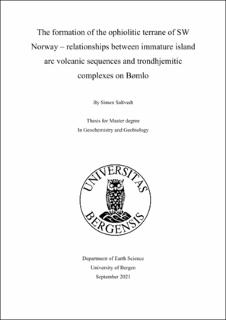The formation of the ophiolitic terrane of SW Norway - relationships between immature island arc volcanic sequences and trondhjemitic complexes on Bømlo
Master thesis
Permanent lenke
https://hdl.handle.net/11250/2831267Utgivelsesdato
2021-10-01Metadata
Vis full innførselSamlinger
- Department of Earth Science [1050]
Sammendrag
Single zircon U/Pb dating, geochemistry, and field descriptions from trondhjemitic and tonalitic intrusions, intruding the Lykling Ophiolite Complex, provide new insights into the origin and evolution of the Early Ordovician ophiolitic terrane of SW Norway. A pluton of trondhjemite and (partly) tonalite, differentiated in the residual melt of ophiolite gabbro, intruded the Lykling Ophiolite Complex at 484 ± 6 Ma. Major- and trace element analyses revealed that dacitic volcanics from the overlying Geitung Unit exhibits similar geochemical characteristics as the trondhjemites and tonalites indicating they are the intrusive and extrusive parts of the same magmatic event. Evidence for internal variations within the Geitung Unit points to a transitional phase where immature island arc dacites and trondhjemites evolved to more mature island arc magma than reported earlier. Two generations of basaltic dikes are reported in the Lykling Ophiolite Complex, where the older generation is related to the development of the ophiolite complex. The second-generation basaltic dikes are correlated with other volcanic groups and complexes on Bømlo; the Siggjo Complex, the Vikafjord Group and the Vardafjell Gabbro. All these lithologies are sourced from the same magma, and formed in a similar type of environment. Zircon REE was used to reconstruct crustal thicknesses for two different lithologies at different stages in the island arc evolution. A trondhjemite and a siltstone from the Geitung Unit revealed crustal thicknesses of 55 and 66 km respectively. These thicknesses are highly contested compared to the modern-day equivalent, the Mariana Arc, in the western Pacific. Crustal thickness findings may be imprecise due to the applicability of this method in this type of formation setting.
